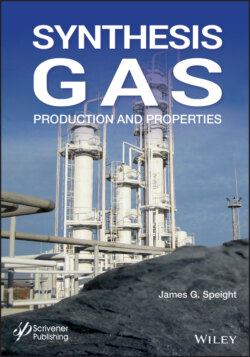Читать книгу Synthesis Gas - James Speight G., James G. Speight - Страница 60
2.6.1.2 Medium Btu Gas
ОглавлениеMedium Btu gas (medium heat-content gas) has a heating value in the range 300 to 550 Btu/ ft3) and the composition is much like that of low heat-content gas, except that there is virtually no nitrogen. The primary combustible gases in medium heat-content gas are hydrogen and carbon monoxide (Kasem, 1979). Medium heat-content gas is considerably more versatile than low heat-content gas; like low heat-content gas, medium heat-content gas may be used directly as a fuel to raise steam, or used through a combined power cycle to drive a gas turbine, with the hot exhaust gases employed to raise steam, but medium heat-content gas is especially amenable to synthesize methane (by methanation), higher hydrocarbon derivatives (by Fischer-Tropsch synthesis), methanol, and a variety of synthetic chemicals.
The reactions used to produce medium heat-content gas are the same as those employed for low heat-content gas synthesis, the major difference being the application of a nitrogen barrier (such as the use of pure oxygen) to keep diluent nitrogen out of the system.
In medium heat-content gas, the H2/CO ratio varies from 2:3 C to 3:1 and the increased heating value correlates with higher methane and hydrogen contents as well as with lower carbon dioxide contents. Furthermore, the very nature of the gasification process used to produce the medium heat-content gas has a marked effect upon the ease of subsequent processing. For example, the CO2-acceptor product is quite amenable to use for methane production because it has (i) the desired H2/CO ratio just exceeding 3:1, (ii) an initially high methane content, and (iii) relatively low water and carbon dioxide contents. Other gases may require appreciable shift reaction and removal of large quantities of water and carbon dioxide prior to methanation.
Town gas is also a medium Btu that is produced in the coke ovens and has the approximate composition: 55% v/v hydrogen, 27% v/v methane, 6% v/v carbon monoxide, 10% v/v nitrogen, and 2% v/v carbon dioxide. Carbon monoxide can be removed from the gas by catalytic treatment with steam to produce carbon dioxide and hydrogen.
